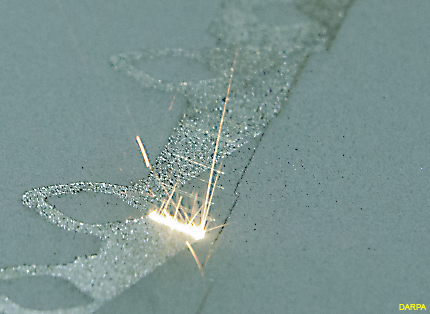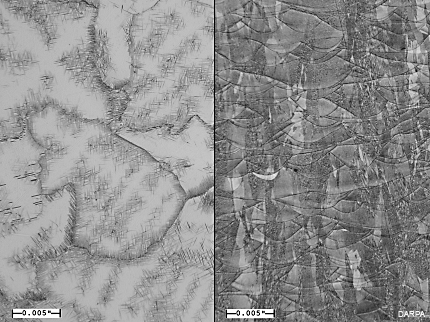Can you trust a 3D printed jet wing?
A new DARPA program looks at additive manufacturing from the inside out in order to establish reliable, repeatable processes.

A laser beam heats a metal powder as part of the additive manufacturing process.
It seems that these days you can 3D print anything, from food to parts for rocket engines. 3D printing has been used to manufacture parts for Army troops in the field and a socket wrench aboard the International Space Station. The technology can be used to print electronics and even to apply live skin cells to help heal severe burns.
The possibilities are endless—but so are the complexities, because 3D printed object aren’t quite like the “real” thing. A 3D printed nickel alloy, for instance, might look and feel like nickel alloy, and even be composed of nickel and the other alloy components. But it’s made differently from the traditional process and its underlying microstructure is different. And before it can be trusted for widespread use in, say, aircraft wings, understanding that underlying structure and its properties is crucial.
That’s the idea behind a new project launched by the Defense Advanced Research Projects Agency, called Open Manufacturing, which will examine 3D printing—more specifically, additive manufacturing—from the inside out and establish parameters for getting the best results in large-scale production.
“The Open Manufacturing program is fundamentally about capturing and understanding the physics and process parameters of additive and other novel production concepts, so we can rapidly predict with high confidence how the finished part will perform,” Mick Maher, program manager in DARPA’s Defense Sciences Office, said in a news release. “The reliability and run-to-run variability of new manufacturing techniques are always uncertain at first, and as a result we qualify these materials and processes using a blunt and repetitive ‘test and retest’ approach that is inevitably expensive and time-consuming, ultimately undermining incentives for innovation.”
As opposed to the traditional casting methods of producing a metal, for example, additive manufacturing builds the metal by layering micron-scale weld beads on top of each other, which can give it different properties and could affect how it would perform in different environments, DARPA said. As well, there’s no guarantee that the same materials made by different machines would behave the same way.

At 100x magnification, the structural differences between a traditionally produced nickel super alloy, left, and the additively manufactured version are apparent.
So to get to the next step, where materials with trusted qualities could be widely produced, DARPA is exploring “rapid qualification technologies” that can be applied to additive and other new manufacturing methods. Open Manufacturing is focusing on three main areas:
Rapid Low Cost Additive Manufacturing, using first-principles and physics-based modeling to predict materials performance for direct metal laser sintering using a nickel-based super alloy powder, which is melted in the manufacturing process.
Titanium Fabrication, combining physics- and data-based informatics models to determine key parameters for large structures such as aircraft wings using an electron beam, rather than a laser, to melt spool-fed titanium wire.
Transition Reliable Unitized Structure, developing data informatics approaches to quantify the composite bonding process an enable adhesives alone to join composite structures, which would eliminate the reliance on mechanical fasteners using in current state-of-the-art techniques.
The program has set up two demonstration facilities—at Penn State University and the Army Research Laboratory—to develop permanent reference depositories that can be tapped by current and future manufacturing efforts. And, the agency hopes, spur a new era for additive manufacturing.
“(T)he risks that come along with new manufacturing have caused a lack of confidence that has stifled adoption,” Maher said. “Through the Open Manufacturing program, DARPA is empowering the advanced manufacturing community by providing the knowledge, control and confidence to use new technology."
NEXT STORY: Navy awards $479M deal for joint tactical radios



